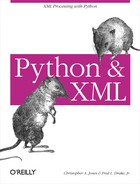Name
ContentHandler
Synopsis
The ContentHandler is
the most used of the SAX handler objects. It is this handler that
receives information about the elements being parsed, their
attributes, and the content between start and end tags. The parse and parseString convenience functions described
in the previous section require a ContentHandler implementation to be passed
in.
setDocumentLocator(locator)SAX parsers are encouraged to supply a
locatorfor finding the origin of events within the document, so that you can determine the end position of any document-related event. Thelocatorobject conforms to theLocatorinterface, described later in this Appendix.startDocument( )When the parser begins a document, it calls this method first and only once, with the exception of
setDocumentLocator, which is called first if implemented.endDocument( )This method is called only once as the very last method invoked by the parser.
startPrefixMapping(prefix, uri)This method is called when a namespace declaration is encountered. The
prefixparameter is the prefix string used in the document, andurirefers to the Universal Resource Indicator (URI) that the prefix represents.endPrefixMapping(prefix)This event occurs at the time the end element with the corresponding
startPrefixMappingis called, indicating that the declaration forprefixhas gone out of scope. It does not indicate that there is no mapping forprefix; an outer declaration may still be in scope.startElement(name, attrs)This event is called each time an element’s opening tag is encountered. The name is the actual tag name of the element. The
attrsparameter is a Python dictionary containing attribute names and values. This is called when Namespace processing is not being used.startElementNS(name, qname, attrs)In this method,
nameis a tuple containing the URI and localname. Theqnameparameter is the actual tag name used in the XML document. Theattrsvariable is once again the Python dictionary containing the attribute name and value pairs. This is called only when Namespaces are being used.endElement(name)This event is called when the end of an element is found, if the start of the element was reported by
startElement.endElementNS(name, qname)This is the corresponding method and event for
startElementNSevent.characters(content)This method is called for each section of character data that is not part of an element or other markup. This method may be called multiple times in what might appear to be a contiguous section of character data. In other words, some parsers may call this method for each line of the document, or some may choose to aggregate lines and call the method between other sections of markup. Either way, all character data is passed through this method call. The
contentparameter contains the actual character data.ignorableWhitespace(whitespace)This method is called by validating parsers when reporting whitespace in element content. Similar to the
charactersmethod mentioned earlier, this might be called multiple times depending on the parser. Validating parsers must call this method. Thewhitespaceparameter contains the actual whitespace encountered.processingInstruction(target, data)This method is called once for each processing instruction found by the parser. XML declarations and text declarations must not be reported in this fashion. Both the
targetanddataparameters are string types containing the processing instruction’s relevant information to the application.skippedEntity(name)The parser calls this method each time an entity reference is found and the content of the entity is not parsed. Nonvalidating parsers may skip external entities and any entities for which they have not seen a declaration.
